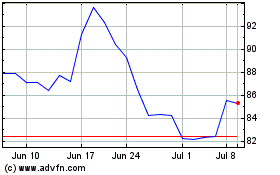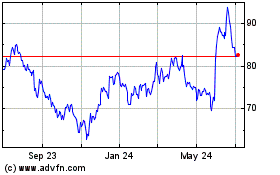By Rachel Feintzeig and Joann S. Lublin
It's hard being the in-between boss.
The temporary chief executives of Valeant Pharmaceuticals
International Inc. and United Continental Holdings Inc. are
currently getting a taste of the challenge while the firms'
full-time leaders are undergoing medical treatment.
Few management assignments hold as many pitfalls as that of the
interim boss, say those who advise and research such leaders.
Temporary leaders must show strength and rally the troops during
uncertain times, but they also can't make bold changes or act like
they will run the place long-term.
In effect, the interim title says: " 'I am only keeping the
chair warm for somebody else,' " says Robert S. "Steve" Miller, a
turnaround expert who twice served as temporary CEO of
Federal-Mogul Corp.
United and Valeant are just the latest big businesses turning to
temporary leaders. Mattel Inc., Starwood Hotels & Resorts
Worldwide Inc., Yahoo Inc. and Best Buy Co. also have tapped
interim bosses in recent years. Such power transfers typically
occur when a CEO falls seriously ill, leaves for a different job or
gets forced out by fellow directors.
Brett Hart, United's temporary CEO, knows what it is like to
work for an acting chief. He was general counsel at Sara Lee Corp.,
when a fellow executive became interim CEO after the permanent
leader suffered a stroke in spring 2010.
At Mattel, Christopher Sinclair was made interim CEO and
chairman when Bryan Stockton resigned in January 2015 after a
disastrous holiday season. Mr. Sinclair was lead director at the
time and the company's longest-serving board member. He ascended to
permanent CEO three months later.
Mr. Sinclair said his Mattel board experience gave him "a sense
of things, but you don't have a really deep understanding" before
becoming the company's temporary top boss.
Among other things, he recalled, he spent his first 45 days
trying to diagnose Mattel's pressing problems and which executives
he could count on for its turnaround. "I don't think there were too
many hours of sleep in those first 45 days," Mr. Sinclair
recalled.
Interim leaders risk criticism for being too assertive or too
docile, according to Jeffrey Cohn, managing director for global CEO
succession planning at recruiters DHR International. Brash action
can anger the company's board of directors, but tepid leadership
can hurt an executive's chances for advancement after the permanent
leader returns or arrives.
Some interim chiefs plucked from senior management resume their
prior role or take a different internal position, such as chief
operating officer, Mr. Cohn says. Regardless, he added, "It is
always a letdown. It's hard to go back to hamburgers when you have
had filet."
About 29% of interim CEOs permanently end up with the top job,
according to research by Gary Ballinger, an associate professor of
commerce at University of Virginia's McIntire School of Commerce,
and a colleague. The analysis of 2,500 public companies found that
those run by temporary chiefs logged lower net income and stock
market performance than those that immediately replaced their
CEO.
The search for a permanent CEO is another distraction for acting
chiefs, Prof. Ballinger says. Meanwhile, less senior executives
"tend to just sit there," and put off launching new products or
making decisions because there is not a permanent, powerful chief
there to endorse ideas or award credit. "There's a certain amount
of strategic stasis," Prof. Ballinger notes.
The financial impact can vary depending on whether the prior
leader left suddenly because of illness or was fired.
A temporary leader's ties to the company matter.
When Steve Jobs rejoined Apple as interim CEO in the 1990s, he
immediately had "moral authority" in the organization, Prof.
Ballinger says. But when Tim Cook tried out the top role during Mr.
Jobs' health crises, he was leading in the shadow of the company's
co-founder--a much more difficult task.
Mr. Miller, a turnaround expert, often resisted the "interim"
title during his years running eight different companies. Now the
head of International Automotive Components Group, Mr. Miller says
he just tried to act like a CEO during his stints as
Federal-Mogul's interim boss. "I would make decisions that made
sense to me and didn't overly worry whether the next guy would do
it differently," he said.
Acting chiefs typically serve for less than a year. The
exception was Sears Holdings Corp.'s W. Bruce Johnson who was
interim head of the retail chain for three years until 2011 when
the company settled on a permanent leader: Lou D'Ambrosio, a
long-time technology executive who had been consulting with
Sears.
Mr. Johnson had been a stopgap chief for so long that he joked
at Sears's annual meeting in 2009 that even his children had taken
to calling him "interim."
In many ways, the job of the interim boss is defined as much by
what a leader cannot do than by what he can.
"It's king for the day," says Davia Temin, CEO of Temin &
Co., a Manhattan-based reputation, crisis management and leadership
coaching firm.
She's currently coaching two interim CEOs, and says the job of
temporary leader can weigh heavily on executives in that role. They
can't commit to an organization too deeply or bond closely with
those within the company because they'll likely be out soon.
Ms. Temin advises such leaders who come from outside the company
to mold themselves to the culture, adjusting everything from how
they dress to how they communicate with employees so they fit in
right away.
"It's a short runway," she says. "An interim CEO will rarely be
able to change the culture."
(END) Dow Jones Newswires
January 07, 2016 19:54 ET (00:54 GMT)
Copyright (c) 2016 Dow Jones & Company, Inc.
Best Buy (NYSE:BBY)
Historical Stock Chart
From Mar 2024 to Apr 2024

Best Buy (NYSE:BBY)
Historical Stock Chart
From Apr 2023 to Apr 2024
